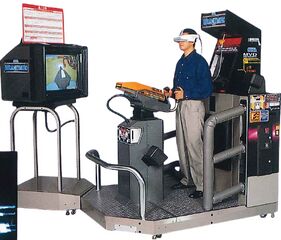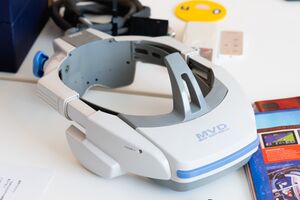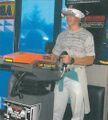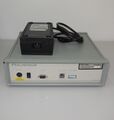Difference between revisions of "Sega Net Merc"
From Sega Retro
(→Videos) |
|||
| Line 10: | Line 10: | ||
}} | }} | ||
}} | }} | ||
| − | The '''Sega Net Merc''' (セガ ネットマーク){{fileref|Becoming Virtual - Bodies, Technologies, Worlds (Thesis by Nicola Green, University of Canterbury, New Zealand, 1999).pdf|page=75}} is an arcade system released by [[Sega]] in 1995. Developed jointly with UK-based virtual reality pioneers [[Virtuality]] under a £3.5 million contract,{{magref|megapower|1|8}} it employs | + | The '''Sega Net Merc''' (セガ ネットマーク){{fileref|Becoming Virtual - Bodies, Technologies, Worlds (Thesis by Nicola Green, University of Canterbury, New Zealand, 1999).pdf|page=75}} is an arcade system released by [[Sega]] in 1995. Developed jointly with UK-based virtual reality pioneers [[Virtuality]] under a £3.5 million contract,{{magref|megapower|1|8}} it employs modified [[Model 1]] boards, a [[Mega Visor Display]] attached to a 3SPACE ISOTRAK II head tracker, and a specialized cabinet to produce VR visuals for software. |
Only one game, ''[[Dennou Senki Net Merc]]'', was created and released for the system before the cancellation of further development; poor critical reception and a shortage of Model 1 hardware causing a limited release have been cited,{{ref|1=https://web.archive.org/web/20210607083239/http://www.system16.com/hardware.php?id=712}} and due to the naming similarity with ''Dennou Senki Net Merc'', the system and game are often used interchangeably in retrospect. | Only one game, ''[[Dennou Senki Net Merc]]'', was created and released for the system before the cancellation of further development; poor critical reception and a shortage of Model 1 hardware causing a limited release have been cited,{{ref|1=https://web.archive.org/web/20210607083239/http://www.system16.com/hardware.php?id=712}} and due to the naming similarity with ''Dennou Senki Net Merc'', the system and game are often used interchangeably in retrospect. | ||
| Line 18: | Line 18: | ||
The Sega Net Merc arcade system consists of several pieces of hardware, used in conjunction in a 1500 x 2010 x 2225 arcade cabinet to produce a simulated virtual reality experience. Most key to it is the [[Mega Visor Display]] headset developed by [[Virtuality]] and [[Sega AM3]], first publicly released as part of the [[VR-1]] theme park attraction at [[Joypolis]] and overseas [[Sega World]] locations in 1994.{{ref|https://web.archive.org/web/20200811132324/https://www.vrfocus.com/2020/07/the-virtual-arena-blast-from-the-past-the-vr-1/}} The headset was designed with the priority of providing comfortability, light weight, and ergonomics for most users, whilst also outputting technically superior graphics to other examples.{{ref|https://web.archive.org/web/20161004200031/https://www.gamebusiness.jp/article/2016/09/14/12597.html}} | The Sega Net Merc arcade system consists of several pieces of hardware, used in conjunction in a 1500 x 2010 x 2225 arcade cabinet to produce a simulated virtual reality experience. Most key to it is the [[Mega Visor Display]] headset developed by [[Virtuality]] and [[Sega AM3]], first publicly released as part of the [[VR-1]] theme park attraction at [[Joypolis]] and overseas [[Sega World]] locations in 1994.{{ref|https://web.archive.org/web/20200811132324/https://www.vrfocus.com/2020/07/the-virtual-arena-blast-from-the-past-the-vr-1/}} The headset was designed with the priority of providing comfortability, light weight, and ergonomics for most users, whilst also outputting technically superior graphics to other examples.{{ref|https://web.archive.org/web/20161004200031/https://www.gamebusiness.jp/article/2016/09/14/12597.html}} | ||
| − | In the Net Merc system, the MVD's graphical output is supplied by | + | In the Net Merc system, the MVD's graphical output is supplied by [[Model 1]] arcade boards, presumably modified in some capacity to support the headset's purported pixel resolution output of 756 x 244.{{ref|https://web.archive.org/web/20200811132324/https://www.vrfocus.com/2020/07/the-virtual-arena-blast-from-the-past-the-vr-1/}} In addition, a 3SPACE ISOTRAK II tracker is used to track head movement as accurately as possible. |
The 3SPACE ISOTRAK II was manufactured by Polhemus Inc. (originally known as Polhemus Navigation Sciences),{{intref|Press Release: 1996-08-05: Sega Selects Polhemus to Develop Next Generation Motion Capture System}} a technology company specialised in motion tracking that was founded in 1969 by Bill Polhemus and based in Colchester, Vermont.{{ref|https://web.archive.org/web/20040806140515/http://www.polhemus.com:80/AboutUs.htm}}{{ref|https://web.archive.org/web/19980704015046/http://www.polhemus.com:80/genfaq.htm}} | The 3SPACE ISOTRAK II was manufactured by Polhemus Inc. (originally known as Polhemus Navigation Sciences),{{intref|Press Release: 1996-08-05: Sega Selects Polhemus to Develop Next Generation Motion Capture System}} a technology company specialised in motion tracking that was founded in 1969 by Bill Polhemus and based in Colchester, Vermont.{{ref|https://web.archive.org/web/20040806140515/http://www.polhemus.com:80/AboutUs.htm}}{{ref|https://web.archive.org/web/19980704015046/http://www.polhemus.com:80/genfaq.htm}} | ||
Revision as of 18:39, 28 October 2021
This short article is in need of work. You can help Sega Retro by adding to it.

| |||||||||
| Sega Net Merc | |||||||||
|---|---|---|---|---|---|---|---|---|---|
| Manufacturer: Sega | |||||||||
|
The Sega Net Merc (セガ ネットマーク)[2] is an arcade system released by Sega in 1995. Developed jointly with UK-based virtual reality pioneers Virtuality under a £3.5 million contract,[3] it employs modified Model 1 boards, a Mega Visor Display attached to a 3SPACE ISOTRAK II head tracker, and a specialized cabinet to produce VR visuals for software.
Only one game, Dennou Senki Net Merc, was created and released for the system before the cancellation of further development; poor critical reception and a shortage of Model 1 hardware causing a limited release have been cited,[4] and due to the naming similarity with Dennou Senki Net Merc, the system and game are often used interchangeably in retrospect.
Contents
Hardware
The Sega Net Merc arcade system consists of several pieces of hardware, used in conjunction in a 1500 x 2010 x 2225 arcade cabinet to produce a simulated virtual reality experience. Most key to it is the Mega Visor Display headset developed by Virtuality and Sega AM3, first publicly released as part of the VR-1 theme park attraction at Joypolis and overseas Sega World locations in 1994.[5] The headset was designed with the priority of providing comfortability, light weight, and ergonomics for most users, whilst also outputting technically superior graphics to other examples.[6]
In the Net Merc system, the MVD's graphical output is supplied by Model 1 arcade boards, presumably modified in some capacity to support the headset's purported pixel resolution output of 756 x 244.[5] In addition, a 3SPACE ISOTRAK II tracker is used to track head movement as accurately as possible. The 3SPACE ISOTRAK II was manufactured by Polhemus Inc. (originally known as Polhemus Navigation Sciences),[7] a technology company specialised in motion tracking that was founded in 1969 by Bill Polhemus and based in Colchester, Vermont.[8][9]
The physical Net Merc system cabinet itself mainly consists of a standing space for the player, motorised "Net Defender MKII" gun yoke controller with two buttons, coin tower, and storage space for the Mega Visor Display when not in use. However, it is also augmented by a monitor outputting gameplay and attract mode footage to onlookers, as well as a 7-strong sound system of speakers.[10] Alongside safety barriers, these surround the play space and the player to create further in-game immersion.
List of games
- Dennou Senki Net Merc (1995)
Artwork
Videos
Video excerpt showing Dennou Senki Net Merc running on the Flight Deck[11][12] floor of Sega World London, taken from episode #7 ("A Special Place") of the third season (1997) of BBC's documentary television series Connections
Video excerpt showing Dennou Senki Net Merc running on the Flight Deck[11][12] floor of Sega World London, taken from 1998 Italian comedy film Cucciolo[13]
Gallery
SegaWorld London, 1996
Sega Park Madrid, 1995
Osaka ATC Galbo, 1998
Polhemus 3SPACE ISOTRAK II[14] Dual Receiver Motion Tracker Front
Polhemus 3SPACE ISOTRAK II[14] Dual Receiver Motion Tracker Back
Magazine articles
- Main article: Sega Net Merc/Magazine articles.
Promotional material
External links
References
- ↑ Sega Arcade History, Enterbrain, page 136
- ↑ File:Becoming Virtual - Bodies, Technologies, Worlds (Thesis by Nicola Green, University of Canterbury, New Zealand, 1999).pdf, page 75
- ↑ Mega Power, "August 1993" (UK; 1993-07-29), page 8
- ↑ http://www.system16.com/hardware.php?id=712 (Wayback Machine: 2021-06-07 08:32)
- ↑ 5.0 5.1 https://www.vrfocus.com/2020/07/the-virtual-arena-blast-from-the-past-the-vr-1/ (Wayback Machine: 2020-08-11 13:23)
- ↑ https://www.gamebusiness.jp/article/2016/09/14/12597.html (Wayback Machine: 2016-10-04 20:00)
- ↑ Press Release: 1996-08-05: Sega Selects Polhemus to Develop Next Generation Motion Capture System
- ↑ http://www.polhemus.com:80/AboutUs.htm (Wayback Machine: 2004-08-06 14:05)
- ↑ http://www.polhemus.com:80/genfaq.htm (Wayback Machine: 1998-07-04 01:50)
- ↑ Saturn Fan, "1995 August" (JP; 1995-07-07), page 82
- ↑ 11.0 11.1 http://tedsegablog.blogspot.com/2017/06/the-rise-and-fall-of-london-trocadero.html
- ↑ 12.0 12.1 https://3.bp.blogspot.com/-IQO53Njw_qI/WdjMwqRsJWI/AAAAAAAAAaI/TaH5RcMm7c4wOFWYltpE-e7rAV380BPRwCLcBGAs/s1600/trocclosed6.jpg
- ↑ https://i.ibb.co/2dpHbqg/Cucciolo-IT-Poster-1998.jpg (archive.today)
- ↑ 14.0 14.1 http://www.polhemus.com:80/isotrkds.htm (Wayback Machine: 1997-03-30 14:09)
| Mega Visor Display | |
|---|---|
| Hardware | Mega Visor Display | VR-1 | Sega Net Merc |
| Software | Space Mission | Planet Adventure | Dennou Senki Net Merc |














